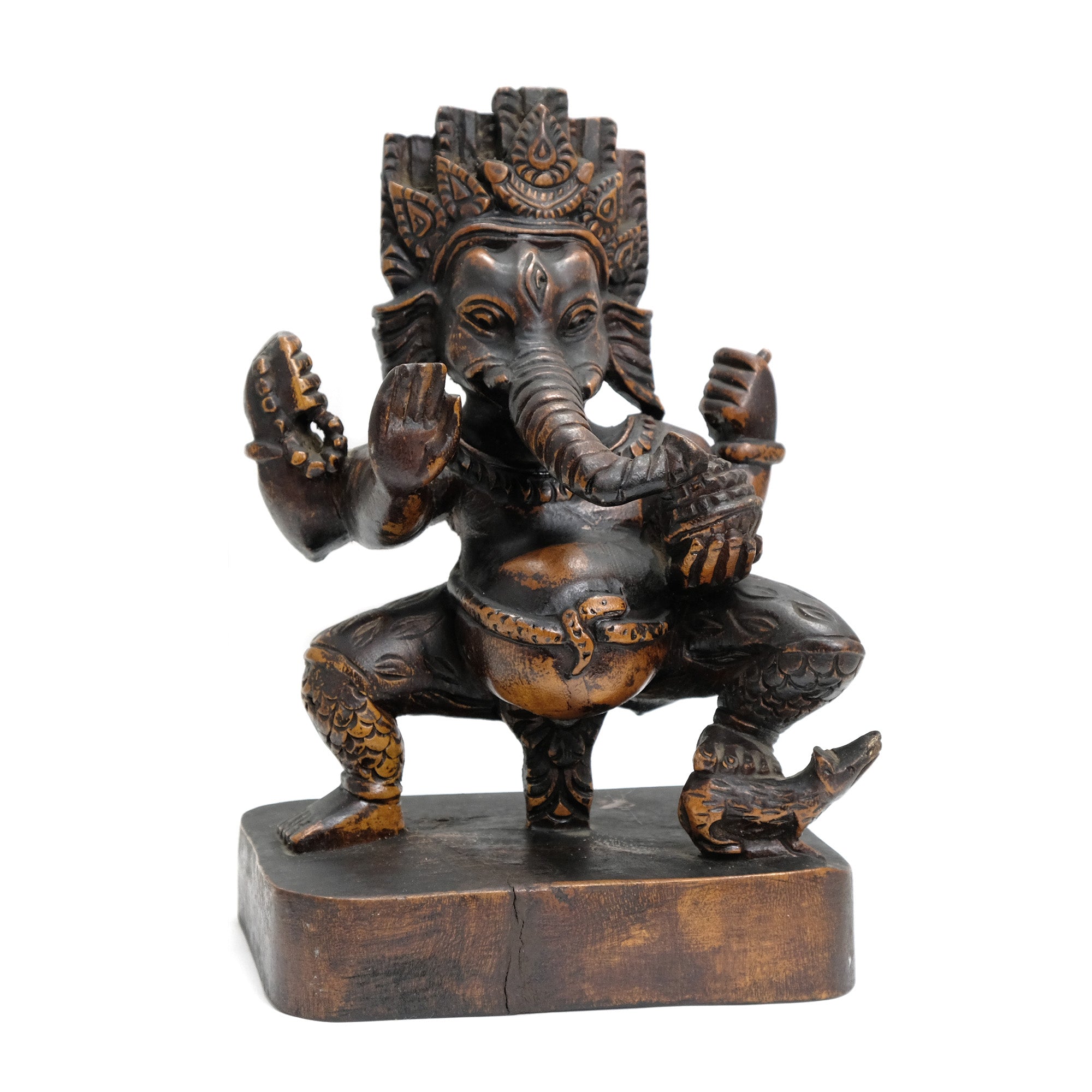Dancing Lord Ganesha Nritya-Ganapati Wooden Sculpture
- Dancing Lord Ganesha Nritya-Ganapati Wooden Sculpture
- Measures approx. 8 1/2″ x 5 3/4″ x 4 1/4″
- According to the Hindu pantheon of Gods, Lord Ganesha is considered to be the one Supreme God. He is known to be the oldest son of Lord Shiva and Goddess Parvati. Lord Ganesha is easily identified amongst all the innumerable Hindu Gods because of his elephant-head and his pot-belly.He is extremely popular and is one of the most worshipped Gods not only in India but outside India too. Ganesha is the God of wisdom, success and good luck. He is also known as the Destroyer of Obstacles and Difficulties. Therefore, you will see Him being honoured and worshipped at the beginning of every new venture, ceremonies or rites.
- Lord Ganesha’s worship, which is famously known as ‘Ganapatayam’ was done from ancient times. It was established as one of the fundamental forms of worship in Hindu religion by one of the saints named Adi Shankara.
- Lord Ganesha the Patron of Different art forms, including dancing
- Lord Ganesha is also worshipped for being the patron of arts, literature and sciences. Arts here refer to performing arts as well as various forms of fine arts. He is often addressed as ‘Rangaraj’ which means a dancer and a performer par excellence.
- Lord Ganesha’s style of dancing is a beautiful synthesis of two dance forms which he inherited from his parents- Tandava from his father Lord Shiva and Lasya from his mother Goddess Parvati. Therefore, before every performance, musicians, dancers or fine arts performers, they honour Him by singing his ode.
- Hindu mythology more than often describe him to be a prolific dancer. This gets represented on paintings, sculptures and scriptures. The Linga Purana and the Ganesh Purana tells us in details why and how Lord Ganesha is considered to be the deity of performing arts.
- The dancing form of Ganapati is called ‘Nritya-Ganapati’. In Sanskrit, the word ‘Nritya’ means ‘dance’. His dancing form is considered to be the 15th of the 32 forms in which the elephant-head Hindu deity emerges.
- Lord Ganesha is mostly shown dancing under a KalpaVriksha tree which is a divine and a wish-fulfilling tree. In his dancing form, he has his right foot raised while his left foot is placed on Earth. This posture signifies the gracefulness with which he moves being the proficient dancer that he is. Many believe that Ganesha used his dance form and his dance moves to entertain his parents and also the other Gods.
- Nritya Ganapati is a happy and a kind-hearted form of the elephant-head, pot-bellied Hindu God. This dancing form of Lord Ganesha depicts him as the connoisseur of performing arts. Hence, devotees and fine arts performers believe that worshipping and honouring Him will bestow them with the Lord’s blessings.
- They will have an enhanced aptitude for learning fine arts, be proficient in them and also bring them success and fame in the specific field of performing arts. This is why we see Lord Ganesha is widely worshipped by artists, especially by dancers and musicians.
- No matter which forms Ganesha is depicted in he is always accompanied by his mouse- his vahana or carrier. The symbolism of the mouse is that how a small animal like a mouse serves as a carrier for the Supreme Lord. Some other scriptures and religious texts say that the little mouse signifies ego, arrogance and all the negative traits in us.
- The Lord sitting on the mouse symbolizes that we should keep our earthly desires and our evil traits in control to attain the blessings showered by Him.
- As already mentioned, Nritya Ganapati means the dancing Ganesha. It is his most vibrant form where he is dancing under a spiritual tree full of joy and exuberance. In this dancing form, Lord Ganesha has four arms and all his fingers are adorned with rings.
- Worshippers and devotees believe that worshipping this dancing form of the elephant-head, pot-bellied Supreme Hindu God brings proficiency and success for those who are involved with performing art form and also fine arts.
- All forms of Lord Ganesha come with a specific mantra. Therefore, the dancing form of the Supreme God has a special shloka too, which is conciliated by all artists but especially by dancers. The Ganesha Vandana mantras or shlokas define God’s quality as a dancer.
- A great number of folk theatre forms and traditional dance forms begin with Ganesh Vandana- this is because of the Lord’s great contributions and association with performing arts like dance, music and drama. For example, the folk theatre dance form of Maharashtra- the Tamasha performances- always begins with Ganesha.
- Dancing Ganesha Mantra:
- “I sing about the Dancing Ganesha, who is of yellow golden colour, who sits below the wish-giving tree, Who holds the noose, goad, Modhaka, tusk shining divine rings arranged on his fingers.”
- Hand carved wood by a Master Carver in Nepal














